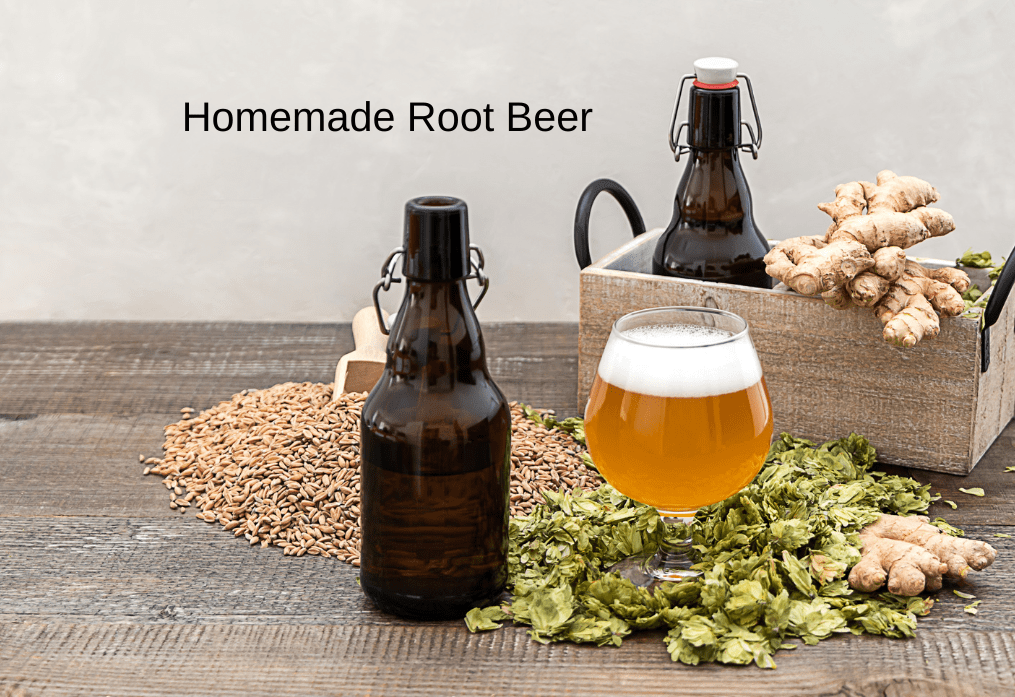Root Beer origin: Early root beers were made from sassafras roots by indigenous tribes in North America who crafted medicinal drinks using sassafras root and various herbs.
The tribes of the Eastern Woodlands, including the Iroquoian and Algonquian peoples, would steep the bark and roots of the sassafras tree in boiling water. This process created a fragrant, reddish-brown tea, which they traditionally believed had healing properties.
This herbal concoction was used to treat various ailments such as fever, stomach issues, and skin problems. It was also believed to help purify the blood and promote overall well-being.
Later, colonists created “small beers” that varied by region, using whatever ingredients were available. Early root beers of this type included various combinations of herbs, barks, and roots. The name “root beer” comes from using roots to create the drink, while “beer” refers to the brewing process used to make it.
Brewing root beer the traditional way has a certain undeniable charm. First, slowly simmer a mixture of roots, bark, and spices to create a decoction. Then, you add a touch of sugar and stir in a starter. Finally, you bottle the brew and let the beneficial bacteria and yeast work their magic.
Sassafras, sarsaparilla, ginger root, and birch give the brew its distinctive flavor without the additives.

- Sassafras gives root beer its distinctive, slightly mint-like flavor.
- Health Benefits
- Anti-inflammatory Properties: Sassafras has traditionally been used to reduce inflammation, which makes it helpful in treating conditions like arthritis and other inflammatory ailments.
- Digestive Aid: The bark and roots were often used to make tea to soothe stomach issues, including indigestion, diarrhea, and stomach cramps.
- Fever Reduction: Sassafras tea was a common remedy for reducing fever, thanks to its potential diaphoretic (sweat-inducing) properties.
- Blood Purification: Blood purification was believed to purify the blood, which was thought to help prevent various diseases and promote overall health.
- Skin Conditions: Due to its purported antiseptic properties, Sassafras was applied topically to treat skin issues such as wounds, sores, and rashes.
- Traditional Uses
- Tea: Indigenous tribes and early colonists made a fragrant, reddish-brown tea by steeping the bark and roots in boiling water. This tea was consumed for its perceived health benefits.
- Topical Applications: Sassafras leaves, bark, and roots were used to make poultices and salves to treat skin problems and minor wounds.
- Culinary Uses: Sassafras was sometimes used as a flavoring agent in foods and beverages, including the original recipes for root beer.
- Aromatherapy: Sassafras’s aromatic properties made it popular in various traditional healing practices, where it was used to create soothing scents for relaxation and stress relief.
- Health Benefits
- Sarsaparilla is traditionally used as a renal tonic and for the complexion.
- Health Benefits
- Anti-inflammatory Properties: Sarsaparilla contains anti-inflammatory compounds, making it helpful in treating conditions like arthritis and other inflammatory disorders.
- Detoxification: It is believed to help detoxify the body by cleansing the blood and removing toxins, which is thought to promote overall health and well-being.
- Skin Health: Sarsaparilla is traditionally used to treat conditions such as psoriasis, eczema, and acne due to its potential antibacterial and anti-inflammatory properties.
- Hormonal Balance: Some traditional uses include treating hormonal imbalances and issues related to menopause and premenstrual syndrome (PMS).
- Digestive Health: Sarsaparilla can aid digestion, alleviate stomach issues, and promote appetite.
- Antimicrobial Properties: The plant has been shown to have antimicrobial effects, which can help fight off infections.
- Traditional Uses
- Tea and Decoctions: Sarsaparilla roots often make tea or decoctions. The beverage is consumed for its supposed detoxifying, anti-inflammatory, and general health-promoting properties.
- Topical Applications: Sarsaparilla extracts and poultices are applied to the skin to treat conditions such as psoriasis, eczema, and other skin irritations.
- Flavoring Agent: Sarsaparilla has been used as a flavoring agent in beverages, including traditional root beer, due to its pleasant taste and aroma.
- Medicinal Tonic: Sarsaparilla has been used as a tonic in traditional medicine to boost overall health, increase stamina, and improve vitality.
- Herbal Remedies: It has been incorporated into various herbal remedies for respiratory issues, joint pain, and other ailments.
- Health Benefits
- Ginger gives this root beer recipe a rich, fiery note. Herbalists use ginger to support cardiovascular and metabolic health, as well as for nausea and stomach upset.
- Health Benefits
- Digestive Aid: Ginger is well-known for its ability to aid digestion. It can help alleviate nausea, vomiting, and indigestion, making it useful for conditions like motion sickness, morning sickness during pregnancy, and postoperative nausea.
- Anti-inflammatory Properties: Ginger contains bioactive compounds like gingerol, which have powerful anti-inflammatory and antioxidant effects. This makes it beneficial for reducing symptoms of inflammatory conditions like osteoarthritis and rheumatoid arthritis.
- Relief from Nausea: Ginger is effective in reducing nausea and vomiting caused by various factors, including chemotherapy, pregnancy (morning sickness), and surgery.
- Pain Relief: Its anti-inflammatory properties also contribute to pain relief. Ginger can help reduce muscle pain and soreness, menstrual pain, and chronic pain conditions.
- Immune Support: Ginger’s antioxidant properties help boost the immune system, protecting against infections and illnesses.
- Cardiovascular Health: Regular consumption of ginger may help lower blood pressure, reduce cholesterol levels, and improve blood circulation, contributing to overall cardiovascular health.
- Blood Sugar Control: Some studies suggest ginger can help lower blood sugar levels and improve various heart disease risk factors in people with type 2 diabetes.
- Traditional Uses
- Culinary Uses: Ginger is widely used in cooking for its distinctive flavor. It is used fresh, dried, powdered, or as an oil or juice in various dishes, beverages, and desserts.
- Herbal Tea: Ginger tea, made from fresh or dried ginger root, is a popular remedy for digestive issues, colds, and flu. It is often combined with lemon and honey for added benefits and flavor.
- Traditional Medicine: In Ayurvedic and traditional Chinese medicine, ginger treats many ailments, including colds, coughs, digestive disorders, and inflammatory conditions.
- Topical Applications: Ginger can be applied topically through poultices or compresses to relieve pain from arthritis, muscle soreness, and other inflammatory conditions.
- Syrups and Extracts: Ginger syrup or extract is often used to remedy colds, coughs, and sore throats. It can be mixed with honey and lemon for added efficacy.
- Candied Ginger: Candied ginger is a sweet treat and a remedy for nausea and digestive issues. It is often used for motion sickness and morning sickness.
- Health Benefits
- Licorice gives the recipe a subtle, anise-like sweetness that pairs well with sassafras. Licorice also supports adrenal health and may help address hormonal imbalances in women.
- Health Benefits
- Anti-inflammatory Properties: Licorice contains compounds like glycyrrhizin, which have potent anti-inflammatory effects. This makes it helpful in treating inflammatory conditions such as arthritis and skin disorders.
- Digestive Health: Licorice is often used to relieve digestive issues, including indigestion, heartburn, and gastric ulcers. It can help soothe the stomach lining and reduce symptoms of acid reflux.
- Respiratory Health: Licorice has expectorant properties, making it beneficial for treating respiratory conditions like coughs, colds, and bronchitis. It helps loosen mucus and ease congestion.
- Immune Support: Licorice’s antioxidant properties help boost the immune system, protecting against infections and enhancing overall immune function.
- Adrenal Support: Licorice supports adrenal gland function, which can help manage stress and fatigue. It is often used in adaptogenic formulations to promote hormonal balance.
- Skin Health: Licorice’s anti-inflammatory and antimicrobial properties make it useful for topical applications and treating conditions such as eczema, psoriasis, and dermatitis.
- Traditional Uses
- Herbal Medicine: In traditional Chinese medicine (TCM), licorice harmonizes the effects of other herbs in formulations. It also treats various ailments, including respiratory issues, digestive problems, and fatigue.
- Gastrointestinal Remedies: Licorice root tea and decoctions have been traditionally used to treat gastrointestinal issues such as ulcers, gastritis, and acid reflux. Deglycyrrhizinated licorice (DGL) is a common form explicitly used for digestive health without the side effects of glycyrrhizin.
- Cough and Cold Remedies: Licorice root is a common ingredient in syrups, lozenges, and teas for treating coughs, sore throats, and other respiratory ailments.
- Skin Treatments: Licorice extracts are used in traditional remedies for skin conditions. It can be applied as a poultice or used in creams and ointments to soothe and heal the skin.
- Flavoring Agent: Licorice has been used for centuries as a flavoring agent in candies, beverages, and other foods. Its sweet, distinctive flavor makes it a popular additive.
- Health Benefits
- Dandelion Root adds the subtlest bitter note to the brew. Dandelion root also supports liver health.
- Health Benefits
- Digestive Health: Dandelion root is known to stimulate appetite and promote digestion. It increases the production of bile, which helps in the breakdown and absorption of fats.
- Liver Support: Dandelion root is often used as a natural detoxifier for the liver. It helps improve liver function by increasing bile production and reducing liver congestion.
- Diuretic Properties: It acts as a natural diuretic, promoting eliminating excess water and toxins from the body. This can help reduce bloating and improve kidney function.
- Antioxidant Properties: Dandelion root contains antioxidants that help combat oxidative stress and reduce inflammation, contributing to overall health and disease prevention.
- Blood Sugar Control: Some studies suggest that dandelion root may help regulate blood sugar levels, which could be beneficial for people with diabetes.
- Anti-inflammatory Effects: Dandelion root’s anti-inflammatory properties can help reduce inflammation and relieve symptoms of conditions like arthritis.
- Immune Support: Dandelion root’s antimicrobial and antiviral properties can help boost the immune system and protect against infections.
- Traditional Uses
- Herbal Tea: Dandelion root tea is a popular traditional remedy for detoxifying the liver, aiding digestion, and acting as a mild diuretic. It is often consumed for its cleansing and health-promoting properties.
- Digestive Tonic: Dandelion root is used as a tonic to stimulate appetite and improve digestive health in traditional medicine. It can be taken in teas, tinctures, or capsules.
- Liver Cleanse: Dandelion root is a common ingredient in liver cleanse protocols. It helps detoxify the liver and improve bile flow, aiding digestion and detoxification.
- Skin Health: Dandelion root’s anti-inflammatory and antimicrobial properties make it ideal for topical applications and treating conditions such as acne, eczema, and psoriasis.
- Traditional Medicine: In traditional Chinese and Native American medicine, dandelion root has been used to treat various ailments, including liver disorders, digestive issues, and kidney problems.
- Health Benefits
Tips to Follow:
- Start with cold water. Tossing herbs straight into hot water may cause proteins in the herbs to seize, preventing the full release of their aromatic compounds and phytonutrients. Cold water eases this process.
- Add the sassafras last. While most woody herbs need time to release their flavor, sassafras are deeply aromatic, and their aroma dissipates quickly with prolonged cooking. So toss it into the pot toward the end of simmering for the best flavor.
- Switch up the sweetener. This root beer recipe uses unrefined cane sugar, but you can also try maple syrup, maple sugar, coconut sugar, and honey. Just make sure you use a caloric sweetener so that the
- root beer ferments.
- Add your starter only once the herbal mixture cools. If you add your starter to the hot herbal decoction, the heat will kill the wild bacteria and yeasts. So add the culture only when the decoction cools to room temperature.
- Use flip-top bottles. Flip-top bottles capture all the carbon dioxide that builds up during fermentation – a fizzy brew for you.
- Pay attention to the temperature in your kitchen. Homemade root beer will ferment faster in a warm kitchen and more slowly in a cold one.
- https://mamavega.com/2024/01/eat-your-way-to-healthy-skin/

Ingredients
Instructions
- Fill a large stock pot with 10 cups cold water, and then spoon in the sarsaparilla, ginger, licorice, dandelion, birch, and star anise.
- Bring to a boil over medium-high heat, then turn down the heat to medium-low. Simmer for 30 minutes, and then stir in the sassafras bark last for best flavoring results, and continue simmering for a further 15 minutes.
- Turn off the heat, and stir in the sugar until it dissolves. Next, allow the decoction to cool to room temperature – about 2 hours.
- Strain decoction, discarding the herbs. Stir in the ginger bug or kombucha, and pour into flip-top bottles – allowing at least 1 to 2 inches of headspace in each bottle.
- Ferment the root beer at room temperature for about 2 days, allowing more time during cold weather. Transfer to the fridge for 3 days to allow the bubbles to set, and serve cold over ice.
Note
A ginger bug is a wild-fermented starter culture made with sugar, ginger, and water. It takes about a little less than a week of daily diligence to make one, and you can use it to make probiotic, naturally bubbly soft drinks, sodas, herbal beers, and tonics.
As it ferments, all the microbes in your starter culture will consume the sweetener. As a result, your root beer will fizz and bubble. And it’s a great source of probiotics, too.
Medical Disclaimer for Mama Vega Enterprises: Optimal Health 360 Blog Post
The information provided on the Mama Vega Enterprises: Optimal Health 360 blog is for general informational purposes only and is not intended as a substitute for professional medical advice, diagnosis, or treatment. Always seek the advice of your physician or other qualified health provider with any questions you may have regarding a medical condition.
Never disregard professional medical advice or delay in seeking it because of something you have read on this blog. The opinions expressed by the authors are their own and do not necessarily reflect the views of Mama Vega Enterprises, its subsidiaries, or its affiliates. Mama Vega Enterprises does not endorse or assume any responsibility for the accuracy or reliability of any opinions, advice, or statements made on the blog.
If you think you may have a medical emergency, call your doctor, go to the emergency department, or call 911 immediately. Reliance on any information provided by Mama Vega Enterprises: Optimal Health 360, its contributors, or other visitors to the blog is solely at your own risk.
Mama Vega Enterprises is not responsible for the content of linked third-party sites and does not make any representations regarding the accuracy, completeness, or any other aspect of the information contained on such sites. The inclusion of any link does not imply endorsement by Mama Vega Enterprises.




